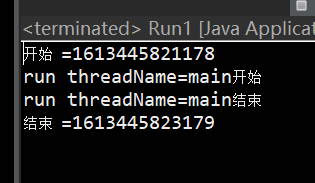方法简单解释
sleep()方法的作用就是在指定的毫秒数内让当前“正在执行”的线程进入休眠状态,在这里这个“正在执行”的线程指的是this.currentThread()返回的线程
下面照例通过一些例子进行方法解释:在下面的测试运行结果重点看他们的输出的顺序
package MyThread;
public class mythread extends Thread{
@Override
public void run() {
try {
System.out.println("run threadName="+this.currentThread().getName()+"开始");
Thread.sleep(2000);
System.out.println("run threadName="+this.currentThread().getName()+"结束");
}catch(InterruptedException e){
e.printStackTrace();
}
}
}
run方法:
package test;
import MyThread.mythread;
public class Run1 {
public static void main(String[] args) {
mythread my=new mythread();
System.out.println("开始 ="+System.currentTimeMillis());
my.run();
System.out.println("结束 ="+System.currentTimeMillis());
}
}
运行结果:

在这里我们发现这个顺序上还是比较符合预期的
我们继续实验:将run变成start
package MyThread;
public class MyThread2 extends Thread{
@Override
public void run() {
try {
System.out.println("run threadName="+this.currentThread().getName()+"begin ="+System.currentTimeMillis());
Thread.sleep(2000);
System.out.println("run threadName="+this.currentThread().getName()+"end ="+System.currentTimeMillis());
}catch(InterruptedException e){
e.printStackTrace();
}
}
}
run一run:
package test;
import MyThread.MyThread2;
public class Run2{
public static void main(String[] args) {
MyThread2 mythread=new MyThread2();
System.out.println("begin ="+System.currentTimeMillis());
mythread.start();
System.out.println("end ="+System.currentTimeMillis());
}
}
运行结果:

在这里发现并没有符合我们的预期,在这里解释一下:由于main线程和MyThread2线程是异步执行的,所以首先打印的肯定是begin和end信息而后再去执行其他线程。
本文内容由网友自发贡献,版权归原作者所有,本站不承担相应法律责任。如您发现有涉嫌抄袭侵权的内容,请联系:hwhale#tublm.com(使用前将#替换为@)